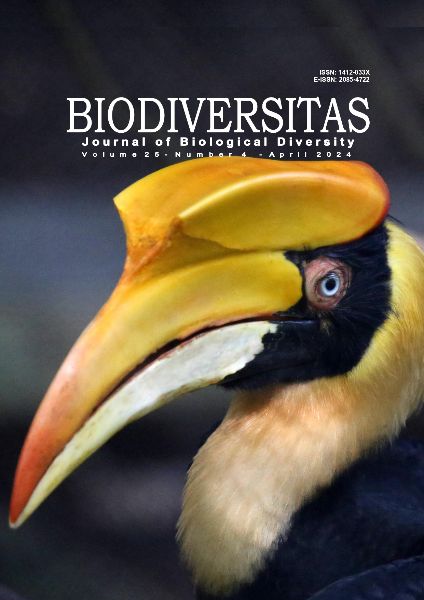Population and distribution of Javan langur (Trachypithecus auratus Geoffroy E. 1812) in Sokokembang Forest, Petungkriyono Sub-district, Pekalongan District, Central Java, Indonesia
##plugins.themes.bootstrap3.article.main##
Abstract
Abstract. Al-Huda IR, Nayasilana IN, Masyithoh G, Setiawan A. 2024. Population and distribution of Javan langur (Trachypithecus auratus Geoffroy E. 1812) in Sokokembang Forest, Petungkriyono Sub-district, Pekalongan District, Central Java, Indonesia. Biodiversitas 25: 1514-1520. Sokokembang is one of the potential habitats that provide a source of feed, means of movement, and shelter for Javan langurs (Trachypithecus auratus Geffroy E, 1812), which are one of the threatened Colobinae, the endemic primate of Java and Bali. Javan langur has been in decline for the last three generations. Javan langur conservation requires data and assessment of natural habitat distribution, size, and condition. This study aims to determine the population size and distribution pattern of Javan langurs in the Sokokembang forest, Central Java, Indonesia, which can be used as a basis for habitat management. The demography parameters used in this study were the population size, population density, age structure, and sex ratio. The study has been conducted from May to June 2023 on plots 18 to 21 of Sokokembang forest, Central Java. The study used the concentration count method and the nearest neighbor analysis using Arcmap 10.8. Eleven groups were identified, with the population size of each group ranging from 3 ± 23 individuals. The population density of Javan langurs was 7.46 individuals/km2. The age structure of Javan langurs in Sokokembang was dominated by the adult age class, and the male-to-female sex ratio was 1:3. The results showed a random distribution pattern of Javan langurs in the Sokokembang forest.
##plugins.themes.bootstrap3.article.details##
Most read articles by the same author(s)
- ARIF SETIAWAN, TEJO SURYO NUGROHO, YOHANNES WIBISONO, VERA IKAWATI, JITO SUGARDJITO, Population density and distribution of Javan gibbon (Hylobates moloch) in Central Java, Indonesia , Biodiversitas Journal of Biological Diversity: Vol. 13 No. 1 (2012)
- IKE NURJUITA NAYASILANA, SUWARNO HADISUSANTO, HERY WIJAYANTO, SRI SUCI UTAMI ATMOKO, DIDIK PRASETYO, JAMARTIN SIHITE, CAREL P. VAN SCHAIK, Behavioral ecology of reintroduced Orangutans in the Bukit Batikap, Central Kalimantan, Indonesia , Biodiversitas Journal of Biological Diversity: Vol. 18 No. 3 (2017)
- AYU ASTUTI, IKE NURJUITA NAYASILANA, SUGIYARTO, AGUNG BUDIHARJO, Community structure of dragonflies (Odonata) in Gunung Bromo’s Forest Area with Special Purpose (FASP), Karanganyar, Central Java, Indonesia , Biodiversitas Journal of Biological Diversity: Vol. 23 No. 5 (2022)
- ARIF SETIAWAN, DJUWANTOKO DJUWANTOKO, A. W. BINTARI, Population and distribution of Rekrekan(Presbytis fredericae ) in the Southern Slope of Mt.Slamet , Biodiversitas Journal of Biological Diversity: Vol. 8 No. 4 (2007)
- MARIO FEBRIYONO, IKE NURJUITA NAYASILANA, GALUH MASYITHOH, Anuran communities in the dry karst ecosystem of Central Java, Indonesia , Biodiversitas Journal of Biological Diversity: Vol. 24 No. 12 (2023)
- M.Y. KHANSA KHARISMAWAN, ISHMA MAULA, PUDJI ASTUTI, ARIF SETIAWAN, Identification and prevalence of soil-transmitted helminth eggs in Javan gibbon (Hylobates moloch) and Javan langur (Trachypithecus auratus) at Petungkriyono Forest, Central Java, Indonesia , Biodiversitas Journal of Biological Diversity: Vol. 23 No. 9 (2022)

